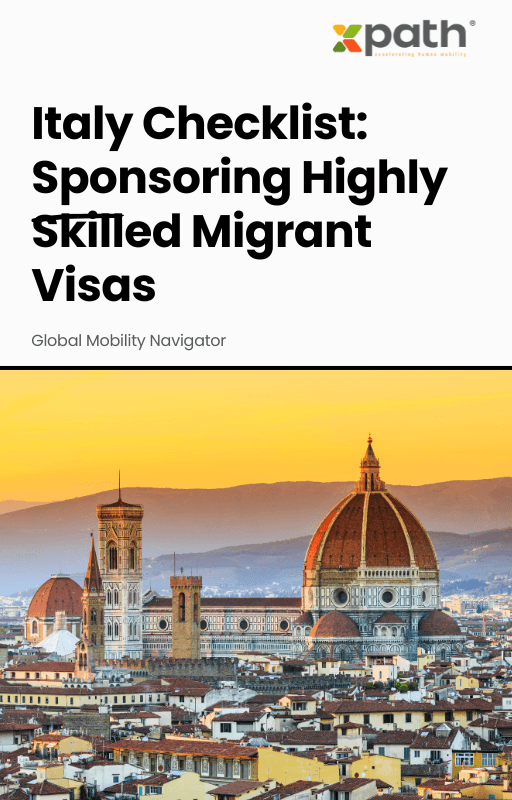Italy Checklist: Sponsoring Highly Skilled Migrant Visas
Grab a copy of a guide to international employee relocation
View E-bookUnlocking global talent is no longer just a perk—it’s an arms race. Businesses hungry for innovation and market expansion find themselves tangled in the logistics and expenses of moving employees across borders. Enter global mobility software: the silent engine behind seamless relocations, streamlined compliance, and smarter spending. But does it genuinely pay for itself? Let’s rip up the spreadsheets and dig deep to reveal why investing in global mobility solutions is more than a cost—it’s a strategic edge in today’s fierce talent wars.
Remote work has blown the doors off traditional workplaces, but global relocation remains complex. HR teams battling spreadsheets, emails, and local vendors know this struggle all too well. According to Mercer’s 2023 Global Talent Trends, 68% of multinational companies expect to increase international assignments, but 60% say their mobility processes are outdated or inefficient. The accelerating pace and complexity of cross-border moves demand a smarter, faster solution, and global mobility software is quickly emerging as that game-changer.
Let’s talk cash. Relocating an employee can cost anywhere from $15,000 to $100,000, depending on destination, family size, and seniority (source: AIRINC Global Mobility Survey). Now, multiply that figure by dozens or hundreds of employees, and you begin to see the mountain HR faces. Historically, companies overspend by up to 20% on relocations because of fragmented workflows, compliance penalties, or lack of consolidated data. A 2022 Deloitte study found that organizations using dedicated mobility software cut average relocation costs by up to 23% through automation, real-time analytics, and vendor consolidation.
One multinational tech firm with offices spanning five continents was dealing with ballooning relocation budgets and compliance headaches. After implementing a global mobility solution akin to xpath.global, they reduced invoice processing time by 70%, slashed assignment setup errors, and achieved cost savings of nearly $3 million in the first year. How? Automated policy application stopped managers from padding benefits, live dashboards ended mystery fees, and streamlined immigration checks wiped away costly compliance fines.
Cost savings are just the tip of the iceberg. The true value of global mobility software? It’s the magic sauce for happier employees and risk-free moves. Imagine a system that automatically tracks visa renewals, alerts HR to regulatory changes, and provides a personalized relocation portal for every assignee. Employees feel supported, less likely to drop out mid-assignment, and HR teams spend less time untangling manual errors or hunting down paperwork. According to PwC’s 2023 Mobility Survey, companies using digital platforms reported employee satisfaction rates rose by 35% for relocations—directly lowering failed assignments and replacement costs.
Still think you can wing it with spreadsheets and sticky notes? Here are a few common pitfalls:
– Compliance nightmares: Did you know EU GDPR fines can reach up to €20 million or 4% of global turnover for improper handling of assignee data?
– Vendor chaos: Juggling local realtors, immigration lawyers, and payroll providers leads to missed deadlines and duplicate charges.
– Data black holes: Ever tried to figure out your true global mobility spend? Without a platform, meaningful analytics are wishful thinking.
The story doesn’t end at cost-cutting. According to KPMG’s 2024 Global Mobility Survey, organizations are using software like xpath.global to enable predictive analytics (anticipating talent needs), dynamic policy management (adjusting support based on real-time business needs), and an integrated ecosystem of partners (from immigration to relocation to payroll—all on one dashboard). Tomorrow’s winners will be those with a 360-degree view, agility, and smart, flexible infrastructure powering their cross-border assignments.
If you’re nodding along and thinking, “My team needs this yesterday,” you’re not alone. When evaluating software, prioritize features like end-to-end automation, customizable workflows, vendor integrations, and robust compliance tracking. But also look at user experience: is it intuitive for both HR and employees? As seen with xpath.global, the best platforms not only streamline admin tasks but also provide a clear and supportive journey for your globally mobile talent.
What is global mobility software?
Global mobility software is a digital platform that helps businesses manage the relocation, assignment, and compliance of employees moving across borders. It automates workflows, tracks costs, and ensures regulatory compliance.
Can mobility software save my company money?
Yes! Research shows that automation, data-driven decision-making, and real-time policy enforcement via mobility solutions can reduce relocation costs by up to 23%.
How does global mobility software improve compliance?
By centralizing data, automating visa and tax reminders, and providing up-to-date regulation tracking, mobility software drastically reduces the risk of compliance breaches and costly fines.
Is it scalable for companies of all sizes?
Absolutely. Modern platforms like xpath.global are designed to serve SMEs to global enterprises, with modular features that scale as your organization grows.
What outcomes can I expect after implementation?
Faster processing times, significant cost reductions, higher employee satisfaction, fewer errors, and robust compliance tracking—are just a few of the game-changing results.
Ready to transform your mobility program? Explore xpath.global’s solutions.

Italy Checklist: Sponsoring Highly Skilled Migrant Visas
Grab a copy of a guide to international employee relocation
View E-book